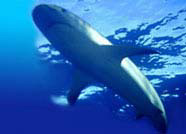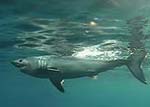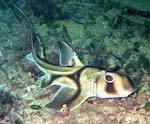


Shark Glossary

 |
 |
 |
|||
| Home | Evolution
| Classification
| Glossary | Biology
| Behavior | Shark
Repellent | Shark
Conservation | Do's &
Don'ts | Did You Know?
Shark Glossary |
 |
||||
|
 Pacific
Angelshark Pacific
AngelsharkSquatina californica, also known as the monkfish, are flat-bodied, bottom-dwelling sharks with a blunt snout. It was named by Ayres in 1859. Classification: Order Squatiniformes, Family Squatinidae (Angel Sharks), genus Squatina, species californica. Pacific Porbeagle The Pacific Porbeagle (Lamna ditropis, also known as the Salmon shark) is found in the Bering Sea and off western North America. It lives from the surface down to moderate depths. The skin is dusky gray above and paler below with white markings. A strong swimmer, it has a wide tail that has a double keel (a second, short ridge running along the upper part of the lower lobe of the tail). A double keel is unusual among sharks; the only other double-keeled tail is on the closely-related Porbeagle Shark, Lamna nasus.] The largest-known Pacific Porbeagle was 10 ft (3 m) long. Classification: Order Lamniformes (mackerel sharks), Family Lamnidae (Mackerel sharks, porbeagles, and white sharks). Pacific Sharpnose  Shark SharkRhizoprionodon longurio is a very common shark that lives in shallow, inshore tropical waters of the eastern Pacific Ocean. It is brown to gray with a lighter belly. Males are about 4.25 feet (1.3 m) long; females are about 2.5 feet (0.75 m) long. This large shark is viviparous. Classification: Order Carcharhiniformes, Carcharhinidae (requiem sharks). Pacific Sleeper Shark Somniosus pacificus, is a sluggish shark that can catch fast-moving prey (like seals). This slate-colored shark lives in cool waters, usually in deep, still water (this shark is mesodemersal). This shark can grow to 23 ft (7 m) long, but averages about 13 ft (4 m ) long. It may be the largest deep sea shark. The meat of this shark is slightly toxic unless it is dried or aged and semi-putrid. It was named by Bigelow and Schroeder in 1944. Classification: Order Squaliformes, Family Dalatiidae , Genus Somniosus, species pacificus.  Paleocarcharias PaleocarchariasPaleocarcharias (which means ancient rough tooth) was a large, ancient shark that lived during the late Jurassic period, about 150 million years ago. Fossils of this shark have been found in Germany (which was under a shallow sea during the Jurassic period). Paleocarcharias had a wide body and large, rounded fins; it is related to the bull and hammerhead sharks. Pangaea Pangaea was a supercontinent consisting of all of Earth's land masses. It existed during the Permian and Jurassic period. It began breaking up during the Jurassic period, forming continents Gondwanaland and Laurasia, separated by the Tethys Sea. Permian Period Also known as "The Age of Amphibians" (280 to 245 million years ago), this is the time when Pangaea formed and Earth's atmosphere was oxygenated to modern levels. It ended with the largest mass extinction and was followed by the Mesozoic Era. Ancient sharks swam the seas during the Permian period. Photophore Photophores are light-producing organs that are found in some fish, cephalopods, and crustaceans. Sharks like the lanternsharks have luminescent photophores; these sharks live in the deep seas in a dark environment.  Porbeagle
Shark Porbeagle
SharkThe porbeagle (Lamna nasus) is a common, fast-swimming, potentially dangerous shark. This mackerel shark can grow to be up to 12 feet (3.7 m), weighing about 350-550 pounds (155-225 kg). They are dark gray on top and white underneath; there is also a small patch of white on the rear edge of the dorsal fin. Porbeagles have a torpedo-shaped body and two keels on the wide tail (the second keel is a short ridge running along the upper part of the lower lobe of the tail), making it an efficient swimmer. The porbeagle feed on fish (mostly mackerel, squid, cod, hake, flounder and other bottom-dwelling fish) with its long, sharp teeth. It lives in cold waters down to about 1,200 feet (370 m). It must swim continuously to get oxygen. Porbeagles are functionally warm-blooded; they retain the heat generated by their muscles and recycle it to heat their body, keeping their body temperature up to 20°F (11°C) warmer than the cold waters they live in. Porbeagles are viviparous, with cannibalistic embryos in the womb; only 2-4 pups survive pregnancy. They live in the North and South Atlantic and the South Pacific Oceans. Order Lamniformes. Portuguese Shark The Portuguese shark, also known as the Portuguese dogfish shark, Centroscymnus coelolepsis, is a chocolate brown shark that is up to 3.8 feet (1.1 m) long (males and females are the same size); the average size is 3 feet (92 cm) long. Juveniles have dark blue skin. It has a heavy body and two tiny dorsal fins with small spines (there is no anal fin). The skin has big, scale-like dermal denticles. The upper teeth are long, pointed, and not serrated; the lower teeth are short and wide. It eats squid and bottom dwelling fish. This bottom-dwelling shark has been netted a depths to 8922 feet (2640 m) - the deepest for any shark. It is ovovivparous; litters have from 13 to 16 pups. Newborns are from 11 to 12 inches (27 to 30 cm) long. The Portuguese shark is found in the Atlantic Ocean, the Mediterranean Sea, and the Pacific Ocean. Classification: Order Squaliformes, Family Squalidae (dogfish sharks), Genus Centroscymnus, species C. coelolepsis.  Portjackson
Shark Portjackson
SharkHeterodontus portusjacksoni is a harmless, sedentary shark from southern Australia. They can grow to be about 5.5 feet (1.7 m), but are, on average a bit smaller. They are light brown, have distinctive bumps over their eyes, a pig-like snout, and some dark brown stripes on the upper back. The teeth are unusual; there are molar-like (wide and flat) teeth in the front of the mouth and small, sharp teeth in the back of the mouth. Port Jackson sharks mostly stay in shallow-water caves and reefs. These sharks are oviparous, laying eggs among the rocks with corkscrew-like spiral cases. Order Heterodontiformes. Prickly Shark  The prickly shark (Echinorhinus cookei) is a slow-moving, harmless, bramble shark. All over its body are thorny dermal denticles (0.2 inch = 5 mm long), giving this shark its name. The prickly shark grows to be about 13 ft (4 m) long. Is skin is grayish brown with black edgings on its fins and white around the mouth and under the head. The prickly shark has a short, stocky body, a spiracle behind each eye (but in front of the five gill slits), two spineless dorsal fins (located very near the tail) and no anal fins. Very little is known about this rarely seen, but common shark. It lives in deep waters of the Pacific ocean, mostly in the Southern Hemisphere in temperate to tropical water; it is only rarely seen in shallow waters. The prickly shark eats fish, crabs, and cephalopods (like squid and octopus). It bears live young in litters of up to 24 pups which are about 16-18 inches (40-45 cm) long each. Classification: Order Squaliformes. Pristiophoriformes A clade of shark that has a long snout, no anal fin, and the mouth underneath. These include the sawsharks.  Pup PupA pup is a newly-born or newly-hatched shark. Shark pups look like tiny versions of their parents. Pups generally have the same coloration and relative dimensions as adult sharks. |
|||||
| Sitemap | Reach To Us | Jimtrade - Business Directory of India | |||||